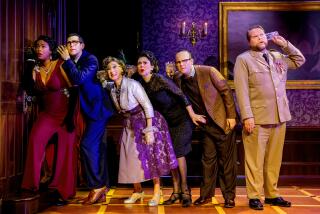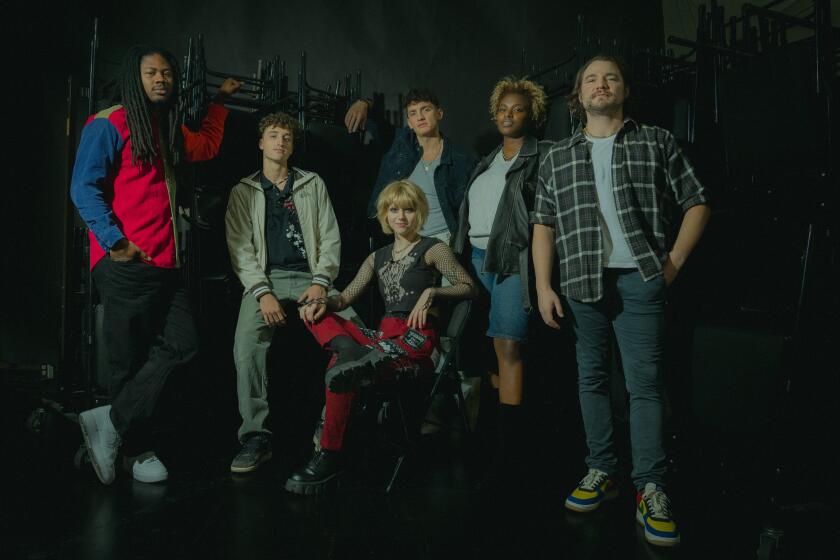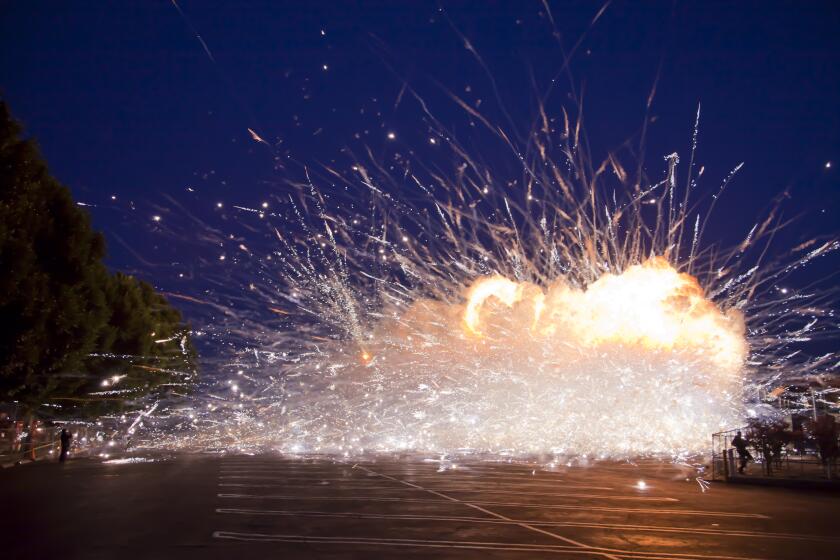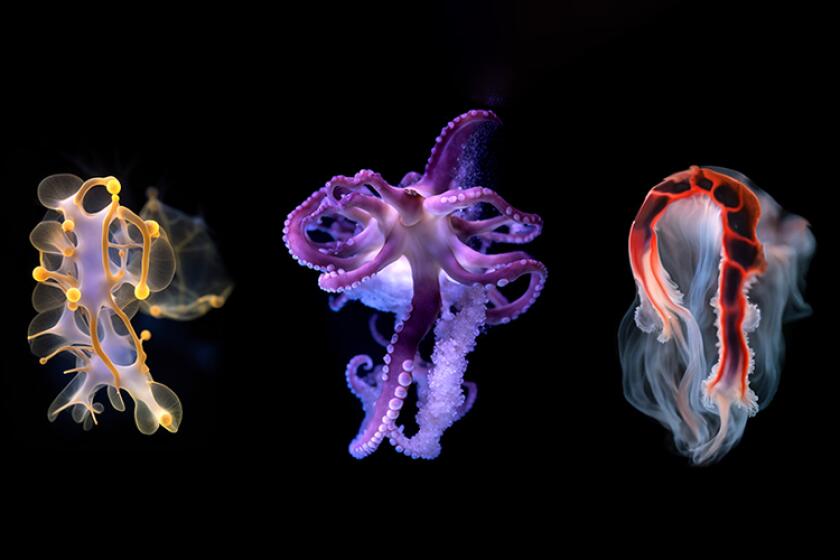Review: Stedelijk Museum’s ‘bathtub’ awash in awkwardness
AMSTERDAM — A few years ago, even before his design for an addition to the Stedelijk Museum was under construction, the Dutch architect Mels Crouwel began comparing the new wing to a giant bathtub.
As PR gestures go, this was an odd one. The public uses nicknames for unusual-looking buildings all the time, often as a way to make sense of a design that strikes them as radical. But it’s rare to hear an architect embrace one — especially before a project is finished, or when the nickname in question is so cheekily antiheroic.
Still, the comparison was apt, and in more ways than Crouwel may have realized. The museum’s sleekly imposing addition, wrapped in a nearly seamless skin of white synthetic-fiber panels, does look very much like a Brobdingnagian wash basin, a well-scrubbed, squeaky-clean home base for some monster truck-sized rubber ducks.
FALL ARTS PREVIEW: Critic’s Picks
More to the point, the new Stedelijk — which opened to the public last week at the northwest corner of Amsterdam’s Museumplein, or Museum Plaza — marks the spot where the aggressive formalism that characterized architecture’s boom years finally went glub-glub.
An overscaled monument flagrantly aloof from its surroundings, the addition is a laggard symbol of an era when the Netherlands, like this country, was awash in capital for boldly sculptural new projects.
As such it’s a reminder of how slow architecture can be. The $159-million extension is the architectural personification of boom-time thinking. But it is making its debut in a chastened and uncertain Europe. Indeed, to tour the new Stedelijk amid endless discussions of bailouts, cutbacks and austerity in the European media — as I did recently with Crouwel and Ann Goldstein, the museum’s director since 2010 — is to experience an unmistakable cognitive dissonance.
Europe as an idea, as a cultural and political project, feels as if it’s contracting, if not fracturing. The museum is meanwhile sloshing noisily across the Museumplein to conquer new territory.
If there were some humor in the design, some flash of levity to cut through its blinding perma-sheen, Crouwel and his colleagues at Benthem Crouwel Architects might have pulled the whole thing off, or at least managed to earn a grudging, ironic respect from the famously tolerant Dutch. And in fact in time the addition, which brings the Stedelijk’s knockout collection of modern and contemporary art back into public view after a closure of nearly nine years, may become a lovable relic of a go-go era in museum design.
But there is nothing of the Claes Oldenburg spirit in the final product, no giant bath towel hanging crisply from the facade with the Stedelijk logo stamped on it like a monogram.
Inside, the Benthem Crouwel wing fares far better. The tub doesn’t sit directly on the surface of the Museumplein but settles gently onto a ground floor wrapped entirely in glass — a transparent pedestal for the porcelaneous object above.
FALL ARTS PREVIEW: Critic’s Picks
After you walk through the glass doors you find yourself in a large, airy entrance hall lined with a pale-gray stone floor. The bottom of the bathtub is visible overhead. The wide southern facade of the old neo-Renaissance Stedelijk building, which opened in 1895, is newly framed here as an interior wall, its wide steps now operating as an indoor gathering place. In the air above those steps, two hallways jut out from the bathtub form and punch through the old museum on the second floor.
A fantastic black-and-white textile by Petra Blaisse covers another, smaller wall to the west, but the real goal of the entrance hall is to make the idea of circulation as visually dramatic as possible. In this it joins a number of other recent museums, by architects as different as SANAA and Zaha Hadid, Renzo Piano and Coop Himmelblau; as far as museum staircases go, there has been a serious arms race going on.
At the new Stedelijk, a theatrical set of cantilevered stairs rises next to an escalator that is wrapped in a chartreuse tube and slices across the space. Both take visitors to a lower level that holds a library as well as a large exhibition space that later this year will hold the museum’s much-anticipated retrospective of the late L.A. artist Mike Kelley.
Upstairs, the galleries in the extension and the redesigned ones in the old building are meant to look nearly identical. Though the new ones are larger and airier, both sets of rooms have wide-plank oak floors and (thanks to recessed baseboards) white walls that seem to float.
As installed by Goldstein, who before moving to Amsterdam to run the Stedelijk was a curator at L.A.’s Museum of Contemporary Art for more than 20 years, the museum’s unusually strong collection — standout work by De Kooning, Guston, Kienholz, Rauschenberg, Matisse, Flavin and many, many more — looks smashing in these galleries.
It’s getting from the city outside to the artwork that’s the problem, since it requires not only confronting the antiseptic enormity of the bathtub but also the awkward manner in which the new wing relates to the Museumplein.
To be fair to the architects, this corner of the Museumplein has become a mess in the last two decades. The Stedelijk has been hemmed in by Japanese architect Kisho Kurokawa’s lousy 1999 extension to the Van Gogh Museum and misguided improvements to the Museumplein itself by landscape architect Sven-Ingvar Andersson.
But the new wing does little to mitigate these existing urban-design problems. It may even exacerbate them. Certainly the small tower for mechanical equipment that Benthem Crouwel decided to add to the museum’s entry plaza has further gummed up the space outside.
Throughout my visit to Amsterdam, locals complained to me about how “un-Dutch” the Stedelijk’s new wing seems — about the mismatch between its aggressive monumentality and the country’s traditional self-deprecation and reserve. Many said the same thing about the ongoing renovation of the nearby Rijksmuseum, which will be complete in the spring; though that project mostly involves interior work, its budget — nearly $500 million at last count — is undeniably grandiose.
That in the end may be the best explanation of why Crouwel seized so early and so publicly on the “bathtub” nickname for his Stedelijk design. It was a preemptive strike of sorts, an attempt to do rhetorically what he’s failed to do architecturally: give this massive addition some appreciable sense of human scale.
christopher.hawthorne@latimes.com
MORE:
CRITIC’S PICKS: Fall Arts Preview
TIMELINE: John Cage’s Los Angeles
More to Read
The biggest entertainment stories
Get our big stories about Hollywood, film, television, music, arts, culture and more right in your inbox as soon as they publish.
You may occasionally receive promotional content from the Los Angeles Times.







